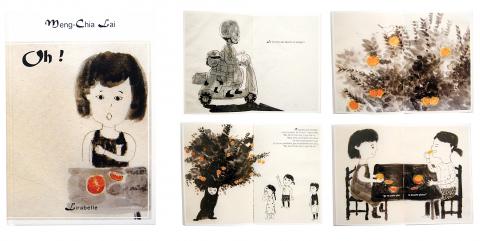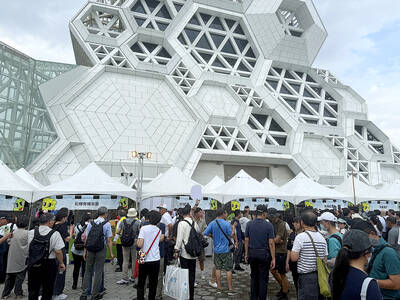Lai Meng-chia (賴孟佳) remembers a time in her childhood when she used to play by the rivers and rice terraces in Yilan County (宜蘭). So when the children’s book author was asked to design the visuals for this year’s Yilan International Children’s Folklore and Folkgame Festival (宜蘭國際童玩藝術節), she naturally chose to depict children running barefoot through sprawling rice fields.
The annual festival which began in 1996 kicks off tomorrow by the Dongshan River Water Park (冬山河親水公園) in the county’s Wuchieh Township, with water games, exhibitions and musical and dance performances by entertainers from around the world. The event, which attracts both the young and the young-at-heart, will last until Aug. 14.
This year’s theme is the white egret bird (白鷺鳥). Lai says she chose it as the main motif in her visuals because they are commonly seen flying around Yilan’s rice fields. It was also the theme of the inaugural festival 20 years ago which she attended as a child.

Photo courtesy of Lai Meng-chia
“We rarely see children playing outdoors [these days],” Lai tells the Taipei Times. “Learning and exploring in nature stirs the imagination more than staring at computer screens.”
A graduate of the Royal College of Art in London, Lai lived and worked in the UK for 13 years before returning to her hometown of Yilan’s Jiaosi Township (礁溪) where her parents used to run a kindergarten.
Growing up around dozens of other children, Lai recalls the simple, unfiltered way in which they viewed the world, something which translates into her illustrations of cheerful, smiling characters and animals. Utilizing simple contours and shapes, her drawings encourage readers of all ages to channel their inner child.
.jpg)
Photo courtesy of Lai Meng-chia
“I think every person has a pair of ‘pure’ eyes in them no matter what their backgrounds and age are,” Lai says.
Lai has been keeping visual diaries since 2004 where she scribbles scenes from everyday life. Her completed artworks are inspired by these observations.
“I play the casting director and set designer to start with and when I start to create, I become the actors in the artwork,” she adds.

Photo courtesy of Lai Meng-chia
In addition to writing and illustrating children’s books, Lai’s repertoire includes being one of the 100 artists in 2013 to design a graphic on a giant Easter egg as a part of the Big Egg Hunt, a yearly Easter egg hunt in London that doubles as a charity fundraising event. Her egg, which revealed squirrels and pigeons hiding in trees, was inspired by the woods near her friend’s cottage in Suffolk.
As for tomorrow’s opening day in Yilan, Lai hopes that the children (and adults) who attend will not only enjoy the performances and activities, but also appreciate Yilan’s abundant natural beauty the way she did as a child.
.jpg)
Photo courtesy of Lai Meng-chia

Following the shock complete failure of all the recall votes against Chinese Nationalist Party (KMT) lawmakers on July 26, pan-blue supporters and the Chinese Communist Party (CCP) were giddy with victory. A notable exception was KMT Chairman Eric Chu (朱立倫), who knew better. At a press conference on July 29, he bowed deeply in gratitude to the voters and said the recalls were “not about which party won or lost, but were a great victory for the Taiwanese voters.” The entire recall process was a disaster for both the KMT and the Democratic Progressive Party (DPP). The only bright spot for

Water management is one of the most powerful forces shaping modern Taiwan’s landscapes and politics. Many of Taiwan’s township and county boundaries are defined by watersheds. The current course of the mighty Jhuoshuei River (濁水溪) was largely established by Japanese embankment building during the 1918-1923 period. Taoyuan is dotted with ponds constructed by settlers from China during the Qing period. Countless local civic actions have been driven by opposition to water projects. Last week something like 2,600mm of rain fell on southern Taiwan in seven days, peaking at over 2,800mm in Duona (多納) in Kaohsiung’s Maolin District (茂林), according to

Aug. 11 to Aug. 17 Those who never heard of architect Hsiu Tse-lan (修澤蘭) must have seen her work — on the reverse of the NT$100 bill is the Yangmingshan Zhongshan Hall (陽明山中山樓). Then-president Chiang Kai-shek (蔣介石) reportedly hand-picked her for the job and gave her just 13 months to complete it in time for the centennial of Republic of China founder Sun Yat-sen’s birth on Nov. 12, 1966. Another landmark project is Garden City (花園新城) in New Taipei City’s Sindian District (新店) — Taiwan’s first mountainside planned community, which Hsiu initiated in 1968. She was involved in every stage, from selecting

The latest edition of the Japan-Taiwan Fruit Festival took place in Kaohsiung on July 26 and 27. During the weekend, the dockside in front of the iconic Music Center was full of food stalls, and a stage welcomed performers. After the French-themed festival earlier in the summer, this is another example of Kaohsiung’s efforts to make the city more international. The event was originally initiated by the Japan-Taiwan Exchange Association in 2022. The goal was “to commemorate [the association’s] 50th anniversary and further strengthen the longstanding friendship between Japan and Taiwan,” says Kaohsiung Director-General of International Affairs Chang Yen-ching (張硯卿). “The first two editions